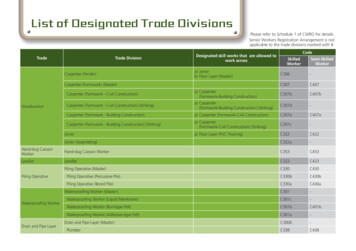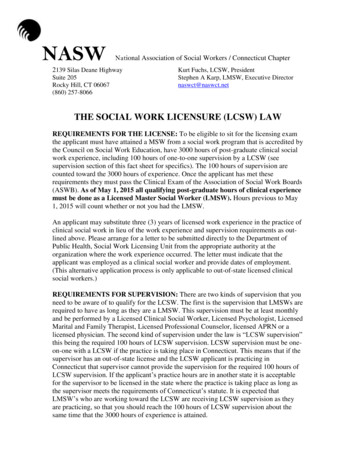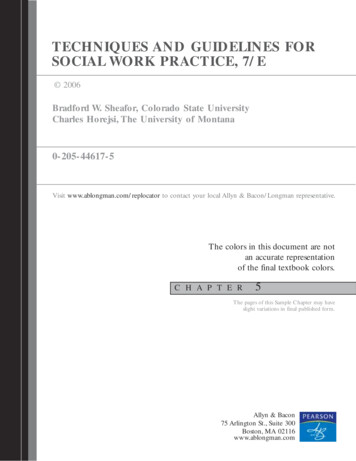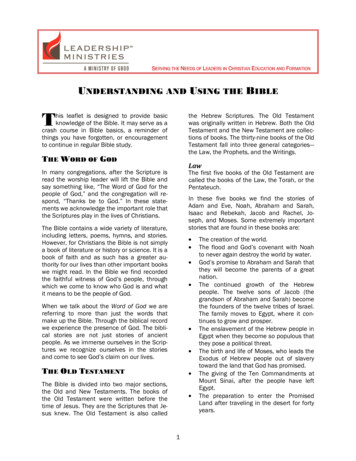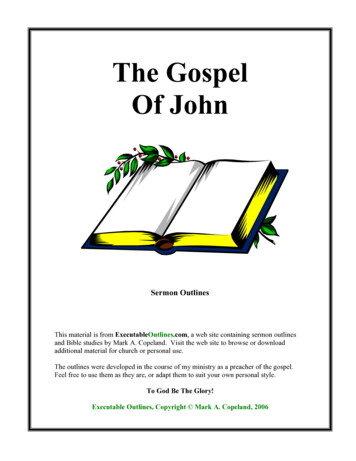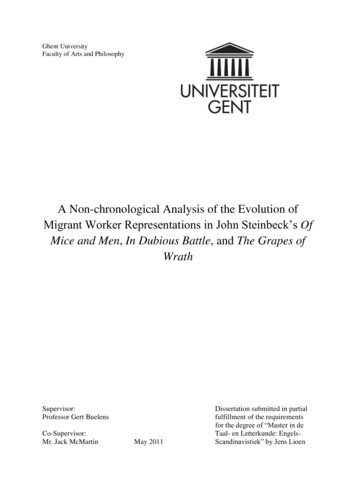
Transcription
Ghent UniversityFaculty of Arts and PhilosophyA Non-chronological Analysis of the Evolution ofMigrant Worker Representations in John Steinbeck‘s OfMice and Men, In Dubious Battle, and The Grapes ofWrathSupervisor:Professor Gert BuelensCo-Supervisor:Mr. Jack McMartinMay 2011Dissertation submitted in partialfulfillment of the requirementsfor the degree of ―Master in deTaal- en Letterkunde: EngelsScandinavistiek‖ by Jens Lioen
1
2A Non-chronological Analysis of the Evolution of Migrant WorkerRepresentations in John Steinbeck‘s Of Mice and Men, In Dubious Battle, andThe Grapes of Wrath
3AcknowledgementsI would like to thank the following people who supported me, either creatively or emotionally, duringthe writing of this MA thesis:Professor Gert Buelens, for his assistance in getting me started on a concrete project.PhD student Jack McMartin, for all his effort in helping me to narrow down and refine my initialtopic, and suggesting the meta-character angle. His insightful remarks and detailed feedback proved tobe invaluable during the writing process.My parents, for the encouraging words during stressful times.My brother, for his advice and willingness to proofread page after page on a subject which normallywould not interest him in the slightest.
4Table of contents1.Introduction . 52.Of Mice and Men . 112.1.Introduction . 112.2.The complexities of George and Lennie‘s relationship . 122.2.1.George‟s selfish interests in his partnership with Lennie: sadism and scapegoat . 152.2.2.George‟s influence on Lennie . 192.3.The universal yet elusive dream of a better tomorrow . 222.3.1.3.2.4.Enigmatic Slim: man, superman, and god . 262.5.The execution of all hope . 27In Dubious Battle. 323.1.Introduction . 323.2.A dynamic meta-character: awakening . 333.3.The dual portrayal of women . 373.4.The meta-character‘s interaction with migrant workers . 403.4.1.Old Dan: the defeatist . 423.4.2.Dakin: the realist . 433.4.3.London: the figurehead . 453.4.4.Group-man . 463.5.4.Diverging dreams . 24The meta-character‘s transformation: maturation, equality and demise . 48The Grapes of Wrath . 534.1.Introduction . 534.2.The meta-character‘s past: old habits and new beginnings . 554.3.The Joad men: a motley crew contrasting the genesis of an altruistic alternative . 574.4.The Grapes of Wrath‟s female migrant workers: maturation at last? . 624.4.1.Ma Joad: Steinbeck‟s pinnacle of womanhood in the three migrant worker novels . 634.5.Return of the dream farm: the migrant workers‘ disillusionment . 674.6.Casy‘s martyrdom and Tom‘s calling: a new dawn for the migrant workers . 695.Conclusion . 776.Works Cited. 81
51. IntroductionIn the latter half of the 1930s, John Steinbeck published three books that focused on thedeplorable situation of migrant workers, in their fight to survive the aftermath of the GreatDepression. In Dubious Battle (1936), Of Mice and Men (1937), and The Grapes of Wrath(1939) show the plight of those on the lower rungs of the social ladder, each clinging to thepromise of a better tomorrow, despite the overwhelming odds against them in a ruthlesseconomic and social climate.1 Trapped in the vicious circle of their migratory existence, theyscour Steinbeck‘s native California looking for the means to ultimately realize their cherishedgoals, ranging from obtaining a personal paradise, to liberating their partners in distress, to acombination of both. Steinbeck is a writer who does not shy away from depicting thegrittiness of his characters‘ hardships in their often squalid conditions, where death isfrequently a matter of course. The rose-colored views of his misfits contrast sharply with thehunger, violence, poverty and social ostracism they have to endure on an almost daily basis.Theirs is a hostile world in which few people genuinely manage to act altruistically towardstheir fellow man. There is no shortage of those who treat the migrant workers as anexpendable labor force, which is preferably subdued, but which can just as easily be removedif need be. In an attempt to withstand the obstacles imposed upon them by their taxingenvironment, some migrant workers unite their strengths in a duo, in the case of Of Mice andMen, and in a larger group in the cases of In Dubious Battle and The Grapes of Wrath, withvarying results.In his portrayal of the migrant worker, Steinbeck changes his outlook on their fatethroughout these two novels and one novella, or play-novelette, as Steinbeck himself referredto Of Mice and Men.2 To better illustrate this change, the approach used here will differ from1 Louis Owens, Trouble in the Promised Land (Boston: G.K. Hall & Co., 1989), xii-xiii.2Elizabeth McMurray, ―Of Mice and Men: Actors in a Play,‖ Steinbeck Studies 3.2 (2006): 103-106.
6the traditional chronological one. Rather than looking at Of Mice and Men as an intermezzobetween two bigger works in Steinbeck‘s oeuvre, it will here be analyzed before In DubiousBattle and The Grapes of Wrath in order to demonstrate the shift in the portrayal ofSteinbeck‘s migrant workers. The unfortunate unraveling of George and Lennie‘s pastoraldream, along with several other disillusioned characters such as the handicapped Crooks,hence the name, and Curley‘s wife in Of Mice and Men, paint a world in which variousfactors such as class, race, gender, age and disability prove to be insurmountable barriers,barring characters from attaining their innermost hopes. This rather pessimistic and bleakdepiction of a handful of characters then here precedes In Dubious Battle‟s vicious struggle ofthe fruit pickers in the Torgas valley under the party members Mac and neophyte Jim Nolan‘scommand, which is channeled through the hulking figure of London. Focusing on the fate ofmigrant workers on a larger scale, Steinbeck shows their attempts at unison under a leadershipthat uses questionable tactics such as exploiting martyrdom in order to direct the group‘semotions. The outcome is, unlike Of Mice and Men, left undetermined since the novel endswith Mac exploiting his companion Jim‘s corpse to stir up the crowd‘s rage and indignationonce again through the use of his companion Jim‘s corpse. In The Grapes of Wrath, Steinbeckcombines both microcosm, with the story of the dispossessed Joad family accompanied by expreacher Jim Casy, and macrocosm, with the intercalary chapters examining the biggerpicture of the Okies‘ perilous migration to California. Their journey certainly does not leadthem to the Edenic California of their dreams, with its fabled fertility and agriculturalabundance. On the contrary, it splinters the family through the death of the older generation,and the departure of certain family members. In fact, the abject poverty the familyexperiences in California vastly exceeds their initial impoverished situation in Oklahoma.Nevertheless, the development of Jim Casy‘s altruistic gospel and its iteration in the actions of
7several characters, most notably Rosasharn‘s final pieta-scene3, provides an element of hopein their otherwise dreary conditions. These Okies, as they are derogatorily referred to, did notneed the likes of a Mac or Jim Nolan to hold the reins and steer them, at all costs, into thedirection of cooperation. Confronted with selfishness and injustice, they learn that their bestchances of survival lie within aiding their fellow man, regardless of their own dire situation.The change in these three works is evident in the difference in interactions between themale pairs, namely George Milton and Lennie Small in Of Mice and Men, Mac and Jim Nolanin In Dubious Battle, and Tom Joad and Jim Casy in The Grapes of Wrath, which feature soprominently in them. With regards to the non-chronological approach suggested in theprevious paragraph, George and Lennie are here examined as the pessimistic starting point ofSteinbeck‘s portrayal of migrant worker characters. The obvious disparity, both in physicalbuild and mental capacity, between the small and shrewd George and the lumbering simpletonLennie has been the source of several dichotomy-based interpretations.4 This indicatesSteinbeck‘s use of the device of the meta-character, or ―divided hero‖ as Howard Levantrefers to it, with both characters at the center of the novel representing contrasting attitudes,which is certainly at its strongest in the play-novelette Of Mice and Men.5 George acts as theauthoritarian father figure over the mentally retarded, and therefore childlike Lennie. Thereare even some instances where George‘s role transforms into that of a master trying to controlhis animalistic companion, who is primarily concerned with satisfying base impulses such aspetting soft things. This tendency, coupled with Lennie‘s lack of restraint over his strength,causes him to unwittingly kill the objects of his affection, and this unfortunate character trait3 Stephen Railton, ―Pilgrim‘s Politics: Steinbeck‘s Art of Conversion,‖ The Grapes of Wrath: Bloom‟s ModernCritical Interpretations, Updated Edition, ed. Harold Bloom, (New York: Chelsea House, 2007), 113-129.4Peter Lisca, ―The Wide World of John Steinbeck, Chapter 8,‖ The Essential Criticism of John Steinbeck‟s OfMice and Men, ed. Michael J. Meyer (Lanham: Scarecrow Press, 2009), 35-44.5Howard Levant, ―The Novels of John Steinbeck, Excerpt from Chapter 5,‖ The Essential Criticism of JohnSteinbeck‟s Of Mice and Men, ed. Michael J. Meyer (Lanham: Scarecrow Press, 2009), 73-85 .
8indirectly leads to his own death. The hope of ever living ―off the fatta the lan‘‖ (p. 16)6 issmashed when Lennie kills Curley‘s wife, causing George to commit what he believes is themercy killing of his doomed companion. Although practically speaking the dream of owninga farm is still within George‘s reach after Lennie‘s death, as the bulk of the money is beingprovided for by old Candy‘s disability compensation, George no longer has any motivationwhatsoever at the end to pursue it without Lennie. The meta-character has been reduced tojust George, who, in losing Lennie, loses the belief in the pair‘s exceptional status, whichsupposedly had distinguished them from all other migrant workers who just aimlessly wastetheir paychecks in the nearest bar or brothel. As an indication of his defeatist attitude, Georgeaccepts another character‘s offer to go for a drink, thus joining the ranks of those whom hehimself had previously described as being trapped in a hopeless existence. The execution endsLennie‘s life and with it the hope of migrant workers ever escaping their harsh environment.The pair of Jim Nolan and Mac in In Dubious Battle is the odd one out since theytechnically are not migrant workers, but nevertheless, Steinbeck‘s portrayal shows theirintegration into a group, and their fierce dedication to the Party‘s cause which in their opinionwill ultimately provide a brighter future for the workers. Refusing to accept defeatism andhopelessness, as displayed in George‘s attitude at the end of Of Mice and Men, Jim‘s initialaction is to join a communist organization referred to as ―the Party‖ with the goal of achievingmeaning in his life through struggle. He volunteers for fieldwork and is assigned toaccompany Mac, who acts as his mentor and teaches him the ins and outs of how to infiltrategroups of workers and incite strikes. While they proclaim to have the best interest of themigrant workers in mind, their methods are thoroughly determined by the belief that the endjustifies the means, as is evident in their unconditional acceptance of the necessity of6All quotations from Of Mice and Men, John Steinbeck are taken from John Steinbeck, Of Mice and Men(London: Penguin Books Ltd, 2006). Subsequent references to page number are included parenthetically in thetext.
9sacrifices for the greater good. Jim proves to be a quick learner, and his calculated analysesand decisions soon surprise Mac, who recognizes a superior strategist in his pupil. Together,they go to great lengths to control the motley crew of workers, which they either view as awild animal that must be taught to do their bidding, or as a machine that needs to be operatedaccording to their desire. The anonymous mass is personified in the general chairmen thatthey elect, of which London is the most prominent character. His interaction with the metacharacter of Jim and Mac bears resemblance to that of Lennie and George, in that he too is aphysically powerful man almost blindly following the orders of his smaller and moreintelligent advisors. However, unlike Lennie, London survives the perilous ordeal, and it isJim instead who pays with his life for his participation in the strike. The death of one half ofthe meta-character is not caused by a known internal agent, as in Of Mice and Men, but by ananonymous external one. Rather than admitting defeat like George by accepting a hopelessfuture, Mac remains militant and uses the corpse of his faceless apprentice to keep thedubious battle, with all its questionable morals and tactics, raging.The Grapes of Wrath distinguishes itself from Steinbeck‘s two previous works, bydepicting a hopeful evolution in the behavior of his Okie characters, an evolution which ismost notable in the Christian allegorical meta-character of Tom Joad and Jim Casy.7 Tom isan ex-convict who, despite his propensity for aggression, does his utmost best to help hisfamily find the illusory promised land in California. Casy is an ex-preacher, who realized thehypocrisy of his ways, and abandoned conventional, organized religion. Having decided totravel with the Joads to California, he gradually develops an ideology that stresses the need ofaltruistic unity during the journey to California. He is different from a character such as InDubious Battle‟s Mac, in that he does not manipulate others into sacrificing themselves, butinstead acts as an exemplar of self-sacrifice. He convinces Tom to let him take the entire7Howard Levant, ―The Fully Matured Art: The Grapes of Wrath,‖ Bloom‟s Modern Critical Interpretations: TheGrapes of Wrath, Updated Edition, ed. Harold Bloom (New York: Chelsea House, 2007), 7-36.
10blame for their fight with a deputy, who had tried to arrest an innocent worker and injured awoman in his attempt to stop the suspect from fleeing . During his incarceration, Casyexperiences an epiphany which helps him realize the importance of organized action, but notin the violent, revolutionary way Mac and Jim Nolan advocate. By chance, he meets Tomagain, just moments before his own death at the hands of vigilantes, which causes Tom to setout and spread Casy‘s message. Compared to the evolution of the meta-character in InDubious Battle, the apprentice here actually survives and there is no exploitation of thecompanion‘s martyrdom, another element of Casy‘s messiah-like function8. Unlike Mac‘s useof hollow rhetoric and artificial martyrs to stir up the migrant workers into a bloodlust, Tomdecides to propagate the more pacifist ideology of his mentor, which is infused with a sense ofspirituality. This development of Tom and Casy‘s meta-character is mirrored in the figures ofMa Joad and her daughter Rosasharn. Whereas women played largely negative or marginalroles in Of Mice and Men and In Dubious Battle, Steinbeck allows them to featureprominently in The Grapes of Wrath, and renders them to embody a similar hopeful altruisticattitude, which culminates in the final scene with Ma Joad encouraging her daughter tobreastfeed a starving man.These three books show a changing perspective on the plight of migrant workers andtheir place in their relentless environment. To better illustrate emergent changes and contrasts, anon-chronological approach will be used to emphasize the shift from Of Mice and Men‟ssense of fatality to In Dubious Battle‘s questionable militancy, and finally to The Grapes ofWrath‘s signs of redemption; an evolution which is also present in the interaction of the malebinary pairs at the center of the novel, or meta-characters, on which Steinbeck focuses.8Stephen Bullivant , ―‘That‘s him. That shiny bastard.‘ Jim Casy and Christology.‖ Steinbeck Studies 16.1(2005): 15-31.
112. Of Mice and Men2.1.Introduction―The best laid schemes o‘ Mice an‘ Men / Gang aft agley, / An‘ lea‘e us nought but grief an‘ pain, /For promis‘d joy!‖9 The poetic allusion to Robert Burn‘s poem in the title of John Steinbeck‘s Of Miceand Men, published in 1937, already reveals the predominant pattern of the characters‘ lives. Mostobviously, it refers to the unattainable nature of George Milton and Lennie Small‘s dreams andaspirations. These two Californian migrant workers, united in an unlikely friendship, share the hope ofone day leaving their uncertain migratory existence behind by realizing their pastoral fantasy ofowning a small farm. George, the smaller and shrewder one of the pair, yearns to be liberated from thestruggle of scraping together a living by doing various odd jobs. His dream consists of truly reapingthe fruits of his labor on his own, self-sustaining farm, which he envisions as a veritable cornucopia.Lennie, a simple, lumbering giant, is mainly concerned with tending and petting rabbits. However, hisbewildered and childlike approach to the world, coupled with a lack of understanding of his ownphysical strength often lands him in trouble, eventually leading to his demise and the unraveling of thepair‘s plan to ―live off the fatta the lan‘‖ (p. 16). They are not the only ones affected by the dream andits subsequent failure. Steinbeck portrays several characters who either share the migrant workers‘illusory goal, or have their own thwarted ambitions. Due to factors such as disability, age, gender orrace, they are forced to occupy a marginal and rather powerless position in the social hierarchy of theranch in particular, and society in general, thus linking them to a fate similar to that of George andLennie. Candy, a grizzled worker who lost his hand on the ranch, is limited to doing menial workbecause of this physical emasculation and his old age. In a rather telling precedent which shows howlittle understanding and compassion his environment has for the weak and elderly, he loses his trustyold shepherd‘s dog when the other workers decide to execute it, claiming the dog has become9Robert Burns, ―To a Mouse,‖ The Norton Anthology of English Literature, Eight Edition, Volume D: TheRomantic Period, eds. Jack Stillinger and Deidre Shauna Lynch (New York: W. W. Norton & Company, 2006),136.
12redundant. After this eye-opener, he is willing to invest his savings into George and Lennie‘s dream,in the hope of escaping a society where the ―survival of the fittest‖ principle reigns supreme. Crooks,the African American stable buck, also does not conform to the ideal image of the young, healthyranch worker. He suffers from a spinal deformity, hence his cognomen. Moreover, the color of his skinacts as an omnipresent barrier, barring him from any real contact with his coworkers. Eager to escapethis racially determined solitude, he cherishes the thought of joining George, Lennie and Candy ontheir farm. However, society‘s ingrained racism is quick to smash his hopes, and to force him backinto what it considers his rightful place. Finally there is Curley‘s wife who is part coquette and partdisgruntled housewife. Firmly believing she was destined to be a Hollywood star because she wasgullible enough to believe a complete stranger‘s wild claims, she now desperately seeks attention onthe ranch in an attempt to overcome the boredom of her unhappy marriage.2.2.The complexities of George and Lennie’s relationshipThe opening chapter firmly establishes the peculiar power relationship between both men . Despite thesize disparity between the two, which as Caren Irr argues, might be based on contemporarystereotypical depictions in cartoons of the scrawny capitalist and the gigantic working man10, Georgekeeps a relatively tight rein on his herculean partner, Lennie. Because of Lennie‘s mental retardation,he is incapable of surviving on his own in this harsh environment, and therefore blindly relies on hiscompanion George to guide him through the trials and tribulations of life. They do not share a familialbond, although later in the book George does lie to the ranch boss about being cousins, in order tojustify their companionship. When Lennie questions George‘s remark, his reply speaks volumes aboutthe ambiguous nature of their friendship: ―Well, that was a lie. An‘ I‘m damn glad it was. If I was arelative of yours I‘d shoot myself‖ (p. 26). Lennie‘s limited intelligence prevents their relationshipfrom being one between equals, but rather results in George having to act as an authoritarian fatherfigure watching over the boisterous Lennie. This is confirmed by other characters‘ observations, suchas Slim‘s remark ―He‘s jes‘ like a kid, ain‘t he‖ (p. 49) and Curley‘s wife‘s conclusion that Lennie is10Caren Irr, ―Queer Borders: Figures from the 1930s for U.S.-Canadian Relations,” American Quarterly, 49.3(1997): 504-530.
13―[j]us‘ like a big baby‖ (p. 102). The very first lines of dialogue show George trying to instill somepractical sense into Lennie, who, like a child, is completely absorbed in his playful activity. Georgecautions against drinking from a river before checking certain indications of water quality. Lennie,however, does not heed his warnings and is more concerned with his ability to create ripples in thewater. Immediately after that, he does his utmost best to mimic George even in the slightest details,such as posture, similar to the way in which children tend to be a copycat of people they idolize.George‘s early interaction with Lennie depicts him as a proponent of the ―spare the rod, spoil thechild‖ adage. Twice he deprives Lennie of his object of affection, a dead mouse, which he keeps in hispocket for petting. Further in the story, when they arrive at the ranch and meet Curley‘s wife for thefirst time, George disciplines Lennie, who is mesmerized by her beauty, with corporal punishment inorder to discourage him from ever interacting with her: ―George [ ] took him by an ear and shookhim‖ (p. 36). Furthermore, he often emphasizes how his responsibility over Lennie is burdensome: ―Icould get along so easy and so nice if I didn‘t have you on my tail‖ (p. 8). Lennie‘s casual remarkduring dinner, stating that he prefers his beans with ketchup, sends George into a frenzy, in which hevoices the underlying tensions in this partnership:Whatever we ain‘t got, that‘s what you want. God a‘mighty, if I was alone I could liveso easy. [ ] No mess at all, and when the end of the month come I could take myfifty bucks and go into town and get whatever I want. [ ] You can‘t keep a job andyou lose me ever‘ job I get. Jus‘ keep me shovin‘ all over the country all the time. [ ]You crazy-son-of-a-bitch. You keep me in hot water all the time. (p. 12)The constant stress of keeping his bumbling companion in check strains their relationship.Yet, despite his frustrations, George cannot deny the presence of some positive reciprocationin the bond that he has with his travelling partner, which forms the basis of their belief in their ownexceptionalism. The two men consider themselves to be different from the typical migrant worker,who is characterized as being trapped in a vicious circle of roaming the country in order to earn ameager wage, which is then immediately spent on temporary thrills, such as alcohol, gambling or
14brothels: ―Guys like us, that work on ranches, are the loneliest guys in the world. [ ] They ain‘t gotnothing to look ahead to‖ (p.15). Their mutual care, on the other hand, leads them to believe that theyare capable of breaking this mould: ―But not us! An‟ why? Because because I got you to look afterme, and you got me to look after you, and that‟s why‖ (p. 15, original italics). This simple statement ofaltruism justifies their self-image and enables them to romantically fantasize about their future farm,which is described as a hedonistic land of plenty in which they can ―live off the fatta the lan‟‖ (p. 16,original italics). As several critics, such as Peter Lisca11and Marilyn Chandler McEntyre12, havepointed out, the repetition of their mantra of one day leaving behind their restless lifestyle and puttingdown their roots takes on a religious tone. McEntyre shows how George‘s demeanor indicates that he―takes on a priestly persona‖ and gives a sermon about ―their private heaven [which] is like anabsolution and a resealing of the bond that keeps them in community and on their chosen path‖.13 Thefact that the two men recite this personal gospel right before their dinner of canned beans, as if theywere saying grace, heightens its religious nature.The unusualness of two migrant workers travelling together is certainly one aspect of Georgeand Lennie‘s unwavering belief in their supposed uniqueness, which is reinforced, sometimesmockingly or suspiciously, by the reactions of others when the pair arrives on the ranch. When theboss is scrutinizing his newly arrived work force, the apparent submissive state of Lennie andGeorge‘s eagerness to talk in his place rouse suspicions that George might be taking advantage of himby depriving him of his wage. Because the ranch boss has ―never seen one guy take so much troublefor another guy‖ (p. 24), George feels compelled to lie about Lennie being a relative who has suffereda severe head trauma. The boss‘s son, Curley, a pugnacious boxer with a penchant for provokingfights with bigger men, also expresses his bafflement at George and Lennie‘s partnership, in a remarkwhich William Goldhurst interprets as ―a particularly nasty innuendo‖ about their sexuality.14 This isthe only reference that explicitly hints at a possible sexual element in their relation. However,11Lisca, ―The Wide World of John Steinbeck,‖ 38-39.Marilyn Chandler McEntyre, ―Of Mice and Men: A Story of Innocence Retained,‖ The Essential Criticism ofJohn Steinbeck‟s Of Mice and Men, ed. Michael J. Meyer (Lanham: Scarecrow Press, 2009), 187-202.13McEntyre, 198.14William Goldhurst, ―John Steinbeck‘s Parable of the Curse of Cain,‖ The Essential Criticism of JohnSteinbeck‟s Of Mice and Men, ed. Michael J. Meyer (Lanham: Scarecrow Press, 2009), 49-61.12
15George‘s defensive reaction to others questioning the pair‘s motivation indicates that he is aware ofsuch a misconception, and that he has probably been confronted with it on several occasions. WhenSlim utters his ―calm invitation to confidence‖ by saying ―Funny how you an‘ him string alongtogether‖, George is immediately on the defensive and wants to know ―[w]hat‘s funny about it‖ (p.44). The actual origin of their partnership, as George then explains to Slim, seems to be a lot morebanal than the boss and his son Curley suspect. Both men grew up in the same town and wereacquainted through Lennie‘s legal guardian, his aunt Clara, who raised him ever since he was a baby.This is the only relative of Lennie who is mentioned in the narrative, while George never refers to anyrelatives whatsoever, apart from stating that he ―ain‘t got no people‖ (p. 45). After Clara‘s death,Lennie simply started tagging along with George, quite possibly because he was the only alternativeauthority figure in his life. No real explanation is given by the characters themselves, but this lack ofclarification of the origin could be seen as an adherence to Steinbeck‘s non-teleological thinking.15Steinbeck‘s biographer, Jackson Benson, explained this philosophy by saying that Stein
Migrant Worker Representations in John Steinbeck‘s Of Mice and Men, In Dubious Battle, and The Grapes of Wrath Supervisor: Professor Gert Buelens Co-Supervisor: Mr. Jack McMartin May 2011 Dissertation submitted in partial fulfillment of the requirements for
